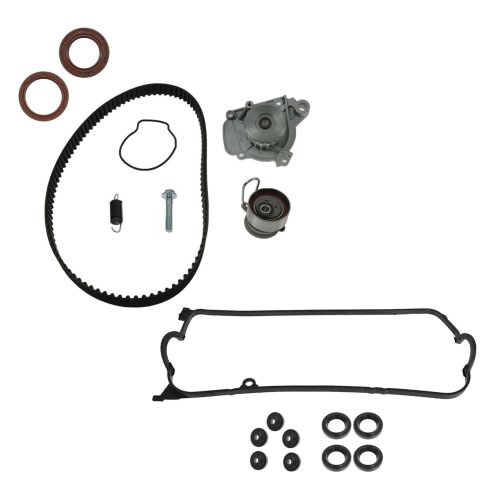1AEEK00622-2001-05 Honda Civic L4 1.7L Timing Belt Kit with Water Pump, Valve Cover Gasket & Seals DIY Solutions ETS00059
Replaces
2002 Honda Civic L4 1.7L Timing Belt Kit with Water Pump, Valve Cover Gasket & Seals DIY Solutions ETS00059
Product Reviews
Loading reviews
4.95/ 5.0
20
20 reviews
1AEEK00622-2001-05 Acura EL Honda Civic Timing Belt Kit with Water Pump Valve Cover Gasket
February 4, 2017
Delivered as promised and working like a champ! Thank You
MATEO
November 14, 2017
Again the price is very good.
First 5000 miles no problem.
Timeing belt is made in U.S.A. I hope that this is real !
Everything is match very well ..
Thank you .
Awesome
March 24, 2018
Fits perfectly! And with instructional videos made it even simpler to install! With no second guessing
Order for hondas
April 13, 2018
Excellent! Parts got here quicker than expected and everything was what it was supposed to be. Ill be purchasing more from yall.
Excellent parts and service!!!
August 12, 2018
I ordered this kit and it matched up exactly with my 2003 honda civic ex. This is not my first time ordering from 1aauto.com and definitely will not be the last. The prices are unbeatable, the shipping is free, the parts are exactly as stated. Thank you 1aauto! And I will for sure be a returning customer 100%
2003 Civic 1.7 Water Pump and timing belt
September 5, 2018
The parts kit was complete and seems to be of very good quality. The instruction video was EXTREMELY realavant and helpful. Only issue, the harmonic balancer bolt was very difficult to remove, though no fault to 1A Auto. Very Satified, Kevin in Missouri.
Water pump kit
September 12, 2018
I am very pleased with the parts I purchased. They arrived in a timely manner and price was excellent. The content of the kit had everything needed for routine maintenance. The kit was well though out. I will use 1auto in the future and share my experience with other.
2002 Honda civic
November 25, 2018
2002 Honda Civic EX coupe. Perfect fit. Package arrived on schedule. Nice that it came will camshaft and crankshaft seals.
5 star
March 19, 2019
found after reviewing the video and checking the prices to local stores found not only the price was spot on all the parts to complete the task were includes in the kit way to go 1aauto thanks Dan
2003 civic 1.7L-Timing belt and water pump kit
March 24, 2019
For years Ive been watching 1A Auto Parts on their DIY videos on YouTube. Ive decided to buy a Timing belt and water pump kit for my 2003 civic 1.7L manual and the parts that came in the mail were far more than excellent. The kit was very affordable and came with more than expected. It all arrived on time and all pre-separated in boxes and ready to install. I give a big (10/10) for parts quality shipping and pricing. 1A Auto is the only company I will buy parts from now on. I Highly recommend this company for buying parts, also check out their YouTube channel. Easy to learn DIY
As described
December 18, 2019
I received everything i need for this process parts looks very high quality.
Combo de Banda de tiempo para Honda civic
August 6, 2020
Muy buena la calidad de las partes ningn problema para ordenar ablan Espaol y muy buen servicio gracias por aser q mis partes aigan yegado completas y a Tiempo
Perfect fit
July 8, 2021
Perfect fit and came with everything needed for a timing belt replacement.
2005 Civic EX Timing belt
July 20, 2021
Best package deal with everything I needed to get the complete timing belt job done and the best price!
Good quality kit - most economic kit out there
September 6, 2021
Came with everything pictured with very quick processing/shipping times. It seemed like all good, high quality parts. Didnt install either of the cam or crankshaft seals because Ive heard from other Honda guys if those arent leaking, leave them alone. Only complaint is that the five valve cover bolt washers seemed a little undersized compared to the original ones that were in there (not sure if thats from the original ones flattening out/compressing over time or what), so I stopped after replacing one of them and left the other four originals in there. Ive only had this kit installed for a couple weeks now, but I do a lot of highway driving and everything seems good so far.
Worth the price!
September 29, 2021
Perfect fit. No issues at all.
November 18, 2021
Havnt used yet but the kit looks good!
Great fit
October 17, 2023
Perfect fit. All the necessary parts, maybe even a few extra.
December 29, 2023
Very happy with kit and the video!
February 20, 2024
Perfect fit . Fast shipping. Better than I expected
Customer Q&A
is there a video for this kit?
March 2, 2016
10
Timing Belt and Water Pump 2001-05 Honda Civic 1 A Auto replacement video
https://youtu.be/3PAgdJ1ZSeA
April 23, 2018
Austin P
Are these belts good quality? I am just nervous to order a belt online I want to make sure it will last on me and not snap !
June 1, 2019
10
1A Auto's house brand parts are manufactured by various aftermarket companies specifically for us and built to your vehicle's exact OEM specifications.
June 1, 2019
Peter L
Will this fit a 2005 Honda civic lx?
August 12, 2023
10
Yo! It worked for my 05 Lx coupe. All the parts you need come in the package.
August 13, 2023
Anthony R
10
Yes, this part will fit your 2005 Honda Civic as long as your engine size is 1.7L.
August 14, 2023
Jean O
Honda is a registered trademark of Honda Motor Co., Ltd. 1A Auto is not affiliated with or sponsored by Honda or Honda Motor Co., Ltd.
See all trademarks.















